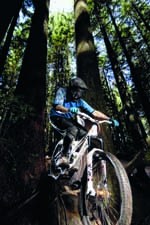 FRAME
FRAME
The reversable shock shuttle supplied with the Demo 7 allows you to choose between a low or high bottom bracket setting, with associated 65/66 degree head angles. Specialized has bucked the trend for 150mm-spacing rear hubs, and stuck with a 135mm rear end to save weight and keep the back end narrow for better clearance. To improve wheel strength, the entire swingarm is offset towards the driveside, then the rear wheel is re-dished to bring it in line with the front triangle. This helps to balance spoke tension on both sides of the wheel. It also causes the sub-stay to protrude quite a lot, and as a result you rub your heel on it until you get used to it — hence the Neoprene cover.
SUSPENSION
To improve the Demo 7’s ability to absorb square-edge hits, Specialized has tweaked the configuration of the suspension to give a slightly more rearward axle path. This, along with the reduced braking influence of the 4-bar suspension design, allows the Demo 7 to steamroll the harshest of braking bumps. A down-specced DHX 4 rear shock lacks the volume adjuster, so you lose the ability to change the end-stroke ramp-up. To compensate, we tried various Boost Valve pressures, finally settling on 200psi. The high pressure has the effect of making the Demo 7 feel more lively, and the extra compression damping stopped the shock from bottoming out as easily, improving chassis stability.
Marzocchi’s fork production may have moved to Taiwan but the 66RCV retains Marzocchi’s ultra-smooth action. The fork is coil-sprung with air assist (which can be topped up with a regular shock pump) and has external rebound and compression adjustment.
The latter is pretty rudimentary, meaning that when you up the compression damping, the fork chokes.
WHEELS
The 2.3in Chunder tyres fitted as standard have good grip and don’t puncture easily. Unfortunately, they are also one of the slowest rolling tyres we have ever ridden. No big deal if you’ve got the luxury of a chair lift — they even allow you to ride off the brakes more, as the tyres are acting like a constant drag brake.
However, try climbing and you really notice how much energy the tyres are sapping. DT 540 rims have a little bit more alloy than the 5.1s but seem just as soft. They are still pretty light so don’t expect them to cope with bad line choices. Overall build quality of the wheels is good but the Specialized hubs aren’t particularly well sealed, so it’s best to avoid hitting them with the pressure washer.
PERFORMANCE
The combination of the Marzocchi fork and the Demo 7’s plush rear end go a long way to isolating the rider from the worst impacts. Pushing the Demo 7 to the limits reveals some of the Marzocchi 66 RCV’s weaknesses, though. Damping isn’t as consistent as Marzocchi’s higher-spec RC2X internals, and there is also a faint top-out when the fork extends as you fly off a jump. Niggles aside, the 66’s are still smoother and more reliable than the equivalent RockShox units specced on the other bikes.
The ultra-long front centre on the medium Demo 7 feels super-stable at speed and inspires confidence on gnarly, rock-strewn chutes. The short chainstays make it easy to pop the front, even on the steepest terrain, and give the bike an obvious rear-wheel weight bias. But it’s not all plain sailing. If you steer this juggernaut away from the motorway trails of the bike park, it starts to come unstuck, as it’s nigh on impossible to manoeuvre it on tight woodwork.
VERDICT
With a faster-rolling set of tyres, the Demo 7 could be a great park bike, as its plush suspension allows you to milk the most from your lift pass without hammering your body on rough, high-traffic trails. Just don’t go for the obvious size choice, as Specialized’s medium is a lot longer than most manufacturers’ large frame sizes. If you are of average height a small Demo 7 is best, as it’s more manoeuvrable at lower speeds.
MBR RATING: 9/10



